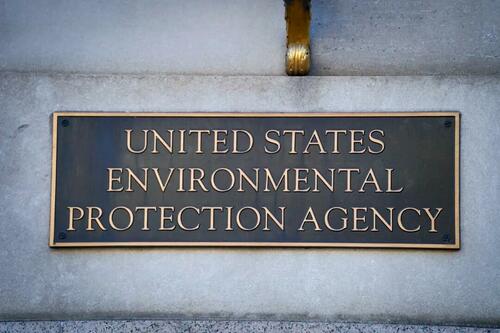
Authored by Katabella Roberts via The Epoch Times,
Attorneys General in 24 states have asked the Supreme Court to block the federal government’s methane standards for the oil and gas sector, arguing the Environmental Protection Agency (EPA) overstepped its authority in issuing the final rule.
The EPA has said the new standards are part of efforts to sharply reduce emissions of methane and “other harmful air pollution from oil and natural gas operations.”
Led by the state of Oklahoma, attorneys general from states including Alabama, Florida, Indiana, Louisiana, and Virginia filed an emergency appeal to prevent the U.S. Environmental Protection Agency (EPA) from enforcing the rule that went into effect this year.
In their Aug. 27 filing, the states argued that while the federal government has the authority to set emissions limits, the rule outlines specific technologies, processes, and methods that the agency believes states must employ to achieve certain emission-reduction targets, among other requirements. The “EPA did not limit itself to its statutory role for existing sources and then leave it to the States to adopt appropriate standards of performance,” they said.
Furthermore the “rule’s ‘presumptive standards’ are onerous, imposing costs on the oil and gas industries that will—as even EPA admits—inevitably be passed onto consumers across the country,” the states wrote.
The EPA’s rule gives states, along with tribes that wish to regulate existing sources, two years to develop and submit their plans for reducing methane from existing sources.
The rule is aimed at reducing “methane and volatile organic compounds (VOCs) from new, modified, and reconstructed sources” and includes emissions guidelines for states to follow as they develop plans to limit methane emissions from existing sources, according to the agency.
The standards include a two-year phase-in period for eliminating routine flaring of natural gas from new oil wells and a one-year phase-in of zero-emissions standards for new process controllers and pumps outside of Alaska.
In the filing, the attorneys general said the agency “understood that, for many States, designing such plans from scratch in a two-year period would be impossible, given the sheer number and diversity of wells involved.”
“States need more than two years to complete this daunting regulatory task, otherwise they risk ’submittal of an inadequately prepared plan that EPA would have to review and reject, leading to unnecessary use of already limited resources.'”
The attorneys general argued that enforcing the rule would also limit the authority of states to establish their own standards for regulating methane and VOC emissions from existing facilities.
“That harms the public interest in the cooperative-federalism regime in the Clean Air Act, generally, and Section 111(d), specifically,” the states argued.
According to the EPA, oil and natural gas operations are the largest industrial source of methane pollution in the United States, and describe methane is a “super pollutant.”
Reducing methane emissions is a “crucial addition to cutting carbon dioxide in slowing the rate of warming of Earth’s atmosphere,” the agency has said.
The EPA’s rules will cut methane emissions from oil and gas operations by nearly 80 percent through 2038 and avoid 16 million tons of smog-forming VOC emissions and 590,000 tons of air toxics, according to the agency.
Additionally, the agency estimates the rules will result in “net climate and ozone health benefits” of $97 to $98 billion dollars from 2024-2038, or the equivalent of $7.3 to $7.6 billion a year, after accounting for the costs of compliance and savings from recovered natural gas.
An appeals court in Washington in July denied a request by the states to put the new methane regulations on hold while their legal challenge plays out in court, prompting them to ask the nation’s highest court.
The Epoch Times has contacted an EPA spokesperson for comment.
Authored by Katabella Roberts via The Epoch Times,
Attorneys General in 24 states have asked the Supreme Court to block the federal government’s methane standards for the oil and gas sector, arguing the Environmental Protection Agency (EPA) overstepped its authority in issuing the final rule.
The EPA has said the new standards are part of efforts to sharply reduce emissions of methane and “other harmful air pollution from oil and natural gas operations.”
Led by the state of Oklahoma, attorneys general from states including Alabama, Florida, Indiana, Louisiana, and Virginia filed an emergency appeal to prevent the U.S. Environmental Protection Agency (EPA) from enforcing the rule that went into effect this year.
In their Aug. 27 filing, the states argued that while the federal government has the authority to set emissions limits, the rule outlines specific technologies, processes, and methods that the agency believes states must employ to achieve certain emission-reduction targets, among other requirements. The “EPA did not limit itself to its statutory role for existing sources and then leave it to the States to adopt appropriate standards of performance,” they said.
Furthermore the “rule’s ‘presumptive standards’ are onerous, imposing costs on the oil and gas industries that will—as even EPA admits—inevitably be passed onto consumers across the country,” the states wrote.
The EPA’s rule gives states, along with tribes that wish to regulate existing sources, two years to develop and submit their plans for reducing methane from existing sources.
The rule is aimed at reducing “methane and volatile organic compounds (VOCs) from new, modified, and reconstructed sources” and includes emissions guidelines for states to follow as they develop plans to limit methane emissions from existing sources, according to the agency.
The standards include a two-year phase-in period for eliminating routine flaring of natural gas from new oil wells and a one-year phase-in of zero-emissions standards for new process controllers and pumps outside of Alaska.
In the filing, the attorneys general said the agency “understood that, for many States, designing such plans from scratch in a two-year period would be impossible, given the sheer number and diversity of wells involved.”
“States need more than two years to complete this daunting regulatory task, otherwise they risk ’submittal of an inadequately prepared plan that EPA would have to review and reject, leading to unnecessary use of already limited resources.’”
The attorneys general argued that enforcing the rule would also limit the authority of states to establish their own standards for regulating methane and VOC emissions from existing facilities.
“That harms the public interest in the cooperative-federalism regime in the Clean Air Act, generally, and Section 111(d), specifically,” the states argued.
According to the EPA, oil and natural gas operations are the largest industrial source of methane pollution in the United States, and describe methane is a “super pollutant.”
Reducing methane emissions is a “crucial addition to cutting carbon dioxide in slowing the rate of warming of Earth’s atmosphere,” the agency has said.
The EPA’s rules will cut methane emissions from oil and gas operations by nearly 80 percent through 2038 and avoid 16 million tons of smog-forming VOC emissions and 590,000 tons of air toxics, according to the agency.
Additionally, the agency estimates the rules will result in “net climate and ozone health benefits” of $97 to $98 billion dollars from 2024-2038, or the equivalent of $7.3 to $7.6 billion a year, after accounting for the costs of compliance and savings from recovered natural gas.
An appeals court in Washington in July denied a request by the states to put the new methane regulations on hold while their legal challenge plays out in court, prompting them to ask the nation’s highest court.
The Epoch Times has contacted an EPA spokesperson for comment.
Loading…






